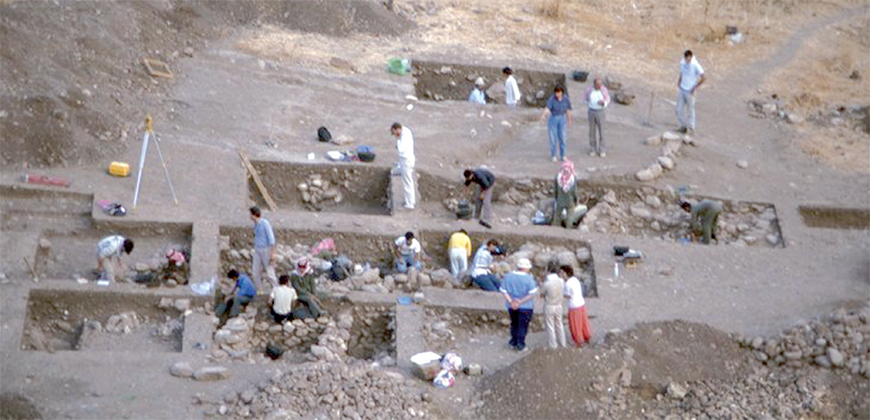
Late Neolithic settlement patterns: Unravelling Wadi Ziqlab’s case
AMMAN — The research in Wadi Ziqlab, located in Northern Jordan, has focused on the distribution and character of small Late Neolithic sites dating to the 6th millennium BC. According to the archaeologists who studied the area, their hypothesis has been that the settlement system for much of this period may have combined isolated farmsteads with small villages and hamlets, organised in a dendritic (branching like a tree) pattern along watercourses.
“This contrasts with the large and medium-sized, aggregated villages, which appear on present evidence to have been typical of the Middle and Late Pre-Pottery Neolithic B (PPNB) and, perhaps, Yarmoukian periods,” noted the scholar Kevin Gibbs, from Barkley.
Scholars could not decide the link between these sites and whether they were contemporary sites or sites that were established as a result of the population movement.
“One of the major goals of this long-term investigation is to provide concrete archaeological evidence for the distributional patterns of Late Neolithic sites, the natures of their occupation, and social and economic relations among sites that were likely contemporary,” Gibbs underlined, adding that through their examination, the team aimed to provide better understanding of the possibility that “dispersed communities” during the Late Neolithic arose, persisted, and transformed themselves through time.
Tabaqat Bûma, a site in the area, uncovered the remains of a small settlement that appears to have been occupied by only one or two households in each of its main Late Neolithic phases, Gibbs continued, noting that the earliest Late Neolithic (LN) use of the site, phase LN1, was apparently as a cemetery, while the following phase, LN2, probably represents the initial habitation of the site.
“Later, the construction activity destroyed most of the architecture belonging to LN2 and phases LN3 to LN5 also represent the occupation phases, with LN3 being the first well-preserved phase at the site,” the professor said.
Furthermore, archaeological survey, including subsurface survey by small test trenches, has detected several other small Late Neolithic sites as well as a village site that was occupied during the Late PPNB, Yarmoukian and Chalcolithic, but not conclusively during the mid- to late sixth millennium cal. BC.
“The site of Tell Rakan is on the edge of a broad alluvial terrace in the canyon of Wadi Ziqlab, some 5 kilometres downstream of Tabaqat Buma. Not only are there springs in its vicinity, but even today the stream is perennial here, providing abundant water for irrigation of orchards,” Gibbs underlined, adding that although his team has no definitive evidence that the site was occupied at the same time as Tabaqat Buma, it remains the best candidate for a village at that time, if indeed there was one.
Excavations in 1999 exposed only about 30 metres square below the Late Chalcolithic levels, and it is possible that sixth-millennium occupation did not extend to the edge of the tell where the excavations were located. Small excavations at Aqaba, only about 600 metres away from Tabaqat Buma, revealed artifacts dating to the Late Neolithic and Early Bronze Age.
“Unfortunately, most of the site appears to have been destroyed during the road construction in the 1970’s, and the Late Neolithic material found there was redeposited, stratigraphically above some Early Bronze Age pits,” Gibbs said, adding that the sample of artifacts recovered, however, yields useful comparisons to other Late Neolithic assemblages.
The same kinds of artifacts that occur at Tabaqat Buma, including pottery, sickle elements, and pierced disks, are represented here, Gibbs elaborated, stressing that to the west of Aqaba, on the same terrace, at Uyyun Hammam, a number of burials occurred.
“While most of these clearly pertain to the Middle Epipalaeolithic deposits there, one secondary burial is stratigraphically later, and perhaps dates to the Late Neolithic. This burial was in a stone lined and stone-filled pit. A very small number of probable Late Neolithic sherds was found in deposits above the burial,“ the scholar underlined.
A number of artefacts were found north of Wadi Ziqlab.
On the other hand, Basatîn, which the Wadi Ziqlab Survey discovered in 2000, had significant occupation, not only in the Late Neolithic but also in the Early Bronze I, Gibbs underlined, adding that the excavations have uncovered features and surfaces associated with artifacts that have apparent affinities to the Wadi Rabah culture in Palestine, while radiocarbon evidence dates these surfaces to the 6th millennium cal. BC.
“A number of overlying stone-founded structures dating to Early Bronze I have associated radiocarbon dates of the 4th millennium cal. BC, and there was also use of the site, probably as orchards associated with the nearby Classical settlement of Tell Abu Fokhkhar, in the 1st century BC,” Gibbs said, adding that the site occupies a sloping terrace, around 25 m ASL, on the south bank of Wadi Ziqlab, immediately opposite Tell Abu Fokhkhar.
Provided by SyndiGate Media Inc. (Syndigate.info).
News Related-
AWS and Clarity AI to use generative AI to boost sustainable investments
-
Ref Watch: 'Enough' of a foul to disallow Man City goal vs Liverpool
-
Day in the Life: Ex-England rugby star on organising this year's Emirates Dubai Sevens
-
Pandya returns to MI, Green goes to RCB
-
Snowstorm kills eight in Ukraine and Moldova, hundreds of towns lose power
-
‘This is why fewer Sikhs visiting gurdwaras abroad’: BJP after Indian envoy heckled in Long Island
-
Inside a Dubai home with upcycled furniture and zero waste
-
Captain Turner aims for Pitch 1 return as JESS bid to retain Dubai Sevens U19 crown
-
No Antoine Dupont but Dubai still set to launch new era for sevens
-
Why ESG investors are concerned about AI
-
Your campsite can harm the environment
-
Mubadala, Saudi Fund deals on US radar for potential China angle
-
Abu Dhabi T10 season seven to kick off with thrilling double-header
-
Eight climate fiction, or cli-fi, books to consider before Cop28
